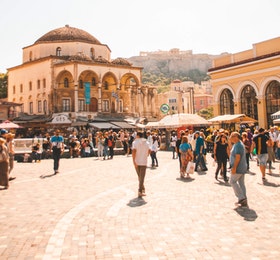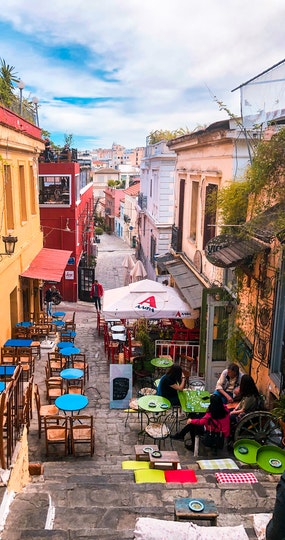The Church of Saint Andrew
The Church of Saint Andrew is a stunning religious site steeped in history and significance. The church is dedicated to the patron saint of Patra, Saint Andrew, who according to tradition, was crucified in this city on a site near the port. The church was built on the exact spot where Apostle Andrew was martyred, making it a sacred place of pilgrimage for Christians. The church boasts a unique and striking architectural design, with a grand dome that is the largest of its kind in the Balkans. The Church of Saint Andrew was built in 1974 and showcases a harmonious blend of Byzantine and modern architectural styles, with intricate arches and a majestic bell tower. The church is not only a place of worship but also a popular tourist destination, drawing visitors from all over the world to marvel at its grandeur and pay their respects to Saint Andrew. The Church of Saint Andrew is an architectural and spiritual treasure, a symbol of the city of Patra that has stood the test of time.
Roman Odeum
The Roman Odeum located in Patra is an ancient architectural masterpiece that has withstood the test of time. Built prior to the Odeum of Athens, it was once a grand and majestic structure, adorned with the statue of Apollo. The Odeum was a site for musical and poetic performances, but it was severely damaged over time due to successive invasions, wars, and earthquakes, and it was almost buried under the remains of other buildings and ground. It was in 1889, during the construction of the port, that the Odeum was rediscovered by accident. The discovery revealed that the Odeum had been lost and buried for centuries. The restoration of the Odeum was a long and arduous task that took many years, and it was not until 1956 that it regained its original shape and splendor. Today, the Roman Odeum stands as a symbol of the rich cultural heritage of Patra and a testament to the enduring legacy of the ancient Roman civilization. It is an architectural treasure that is not to be missed by anyone visiting the city.
Medieval Castle
The Medieval Castle of Patra, perched on the highest point of the city, towers above the Roman Odeum. This fortress was built on the site of an ancient Acropolis, dating back to the 6th century BC, and has served as a bastion of defense for centuries. Throughout history, the castle has been under the control of various conquerors, such as the Franks, Byzantines, and Turks, and it has been a key stronghold in times of war and sieges. Even until the Second World War, the castle was still in use, and it protected the city from invaders. Today, the Medieval Castle of Patra is a striking reminder of the city's rich and tumultuous history, offering visitors a glimpse into the past and a panoramic view of the present-day city.
Apollo Theatre
The Apollo Theatre in Patra is an architectural treasure, built in 1972 by the renowned German architect Ernst Ziller. This grand theater was designed to be a replica of the famous La Scala di Milan, and since its construction, it has been a vital part of the city's cultural and artistic scene. The Apollo Theatre has been the stage for some of the greatest works by composers such as Verdi, Puccini, and Bizet, and it has also played host to many performances by renowned Greek theatrical troupes. Not only a performance venue, but the Apollo Theatre also stands as a symbol of Patra's rich cultural heritage and its dedication to the arts. The Apollo Theatre is a must-see destination for anyone interested in the cultural and artistic offerings of Patra.
Voundeni Mycenaean Cemetery
The Voundeni Mycenaean Cemetery is an archaeological site located near the ancient city of Voudeni, in the northeastern part of the Peloponnese, Greece. The cemetery contains a large number of Mycenaean tombs, dating back to the Late Bronze Age (1400-1100 BC). These tombs are believed to have belonged to the elite members of Mycenaean society and provide valuable insights into the society's funerary practices, beliefs, and customs. The cemetery is also a significant source of Mycenaean pottery, as well as other grave goods such as weapons, jewelry, and seals. The Voundeni Mycenaean Cemetery is an important historical site, it is an open-air museum that offers visitors a glimpse into the past and is an important source of knowledge about the Mycenaean civilization.
Rio-Antirrio Bridge
The Rio-Antirrio Bridge is a cable-stayed bridge that spans the Gulf of Corinth in Greece, connecting the towns of Rio and Antirrio. The bridge is one of the longest multi-span cable-stayed bridges in the world, with a main span of 2,250 meters. It was opened to the public in 2004 and has greatly improved transportation and accessibility between the mainland of Greece and the Peloponnese peninsula. The bridge has a distinctive architectural design, with two cable-stayed towers that rise up to 156 meters above the sea, and it features a roadway that can accommodate both cars and trains. The Rio-Antirrio Bridge is not only an engineering marvel but also a major tourist attraction, offering visitors spectacular views of the Gulf of Corinth and the surrounding landscape.
Kostis Palamas Home
Kostis Palamas' home, also known as Kostis Palamas Museum, is a historic house located in the city center. It was the birthplace and childhood home of the famous Greek poet and playwright, Kostis Palamas. The house was built in the 19th century, and it was where Palamas spent his childhood and youth, and where he wrote some of his most famous works. The museum has been converted into a cultural center, and it features a collection of personal items, photographs, and documents that belonged to the poet, as well as copies of his works. Visitors can also see the room where Palamas wrote his poetry and the family's living quarters. The museum is open to the public and is a popular destination for tourists, literature lovers, and those who want to learn more about the life and work of the famous Greek poet, Kostis Palamas.
Patras Hammam
The Patras Hammam is a historic public bath located in the city of Patras, Greece. Built in the 19th century, it is one of the few surviving examples of Ottoman-era architecture in the region. The hammam was a social hub where people would gather to bathe, relax, and socialize. The hammam is composed of a series of rooms, including the cold room, the warm room, and the hot room, each with a specific temperature and function. The hammam's interior is decorated with intricate geometric patterns and colorful mosaics, and it features a central dome that provides natural light. The hammam was closed for decades; however, now it is open to the public and is visited by many tourists who want to experience the traditional and historical aspect of hammams. It is also a great opportunity to explore the Ottoman culture and architecture in Patras.
Tradition
Patras Carnival
The Carnival of Patras is one of the most famous and celebrated carnivals in Greece. It is held annually in the city of Patras, usually during the period of January to March, and it is considered one of the largest carnivals in Europe. The carnival features a wide variety of events, including colorful parades, live music, folk dancing, and traditional costumes. The highlight of the carnival is the parade of the "Kamilos" which is a giant stuffed figure that is carried through the city streets on the last Sunday of the carnival. The Kamilos is usually around 15 meters high and is a symbol of the carnival. Visitors can also enjoy the "Vlachopazaro" which is a parade of local groups dressed in traditional costumes, following the Kamilos. The carnival of Patras is a unique experience that showcases the rich cultural heritage of the city, and it is a must-see event for anyone visiting Patras during the carnival season.
Bourboulia
Bourboulia is a traditional custom that takes place in the city of Patras, Greece. It is an evening event that features balls where ladies are free to attend without the need for a ticket or an escort. However, they must wear a black wide and long domino, as well as a mask to conceal their identity. This allows the ladies to take the initiative in choosing a gentleman at the ball. Historically, the custom of Bourboulia served as an annual escape from the strict social conventions surrounding interactions between the sexes.
Hidden Treasure Game
The Hidden Treasure Game is a carnival event in Patras, Greece that is organized by permanent carnival teams. Each team has a unique name and a theme for their disguise, which also serves as the name for that year's event. The game includes a variety of question from various fields of knowledge such as history, literature, mathematics and general knowledge. The clues to these questions are hidden throughout the city and participants must work together to find them. At the end of the event, teams are scored, and the team with the highest score is declared the winner. It's a fun and exciting way to engage with the city's history and culture while having fun with friends and family.
Horseback to Saint George
The equestrian procession to Saint George is a cherished tradition in the village of Vasilikos. Following the conclusion of the Divine Liturgy at the Holy Church of Saint George, a parade begins with young riders bearing the Greek flag and the banner of the church leading the way. Priests and the devout followers follow, carrying an icon of the saint. In preparation for the event, the women of the village spend the day prior creating an array of traditional treats, which are distributed to the participants during the procession outside the church of Saint George.




